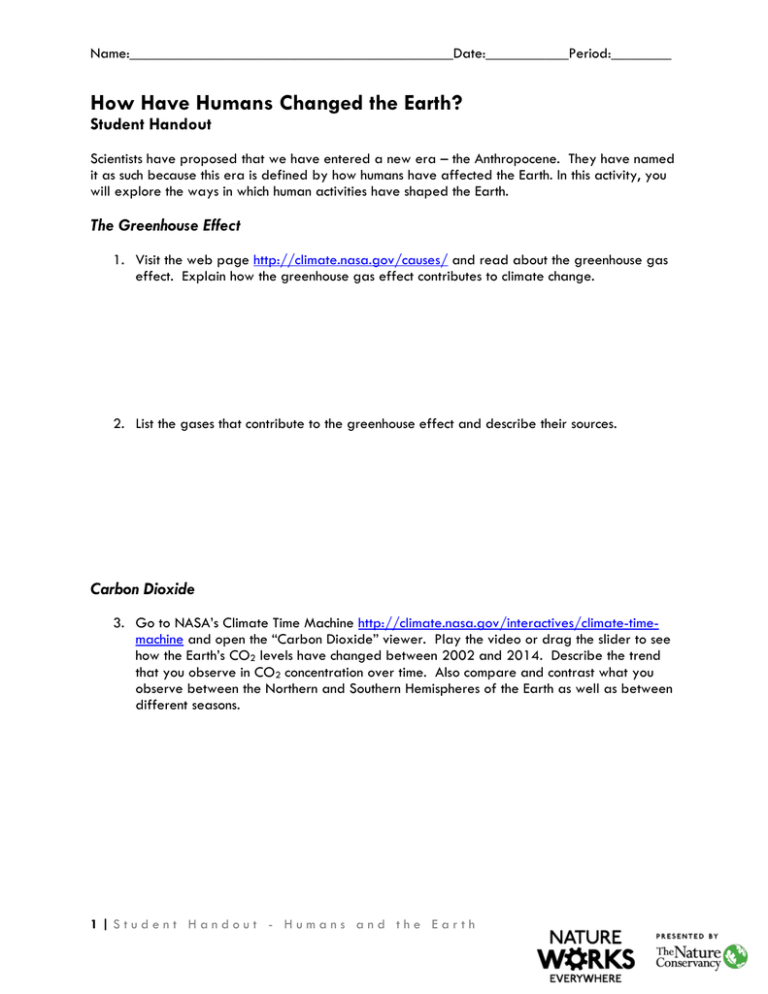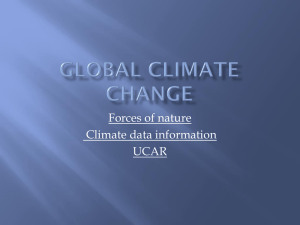How Have Humans Changed the Earth?
advertisement

Name:___________________________________________Date:___________Period:________ How Have Humans Changed the Earth? Student Handout Scientists have proposed that we have entered a new era – the Anthropocene. They have named it as such because this era is defined by how humans have affected the Earth. In this activity, you will explore the ways in which human activities have shaped the Earth. The Greenhouse Effect 1. Visit the web page http://climate.nasa.gov/causes/ and read about the greenhouse gas effect. Explain how the greenhouse gas effect contributes to climate change. 2. List the gases that contribute to the greenhouse effect and describe their sources. Carbon Dioxide 3. Go to NASA’s Climate Time Machine http://climate.nasa.gov/interactives/climate-timemachine and open the “Carbon Dioxide” viewer. Play the video or drag the slider to see how the Earth’s CO2 levels have changed between 2002 and 2014. Describe the trend that you observe in CO2 concentration over time. Also compare and contrast what you observe between the Northern and Southern Hemispheres of the Earth as well as between different seasons. 1|Student Handout - Humans and the Earth 4. Why do you think there is a difference between the levels of CO2 between hemispheres during different seasons? For hints, check out these resources: Science Bulletin: “Earth’s Green Carbon Machine” by the American Museum of Natural History: https://www.youtube.com/watch?v=geR2KsF53y4 Earth’s Green Carbon Machine Backgrounder: http://www.amnh.org/content/download/43544/660599/file/Earth's%20Green%20Ca rbon%20Machine%20Backgrounder.pdf Article “Why are Seasonal CO2 Fluctuations the strongest at Northern Latitudes”: https://scripps.ucsd.edu/programs/keelingcurve/2013/05/07/why-are-seasonal-CO2fluctuations-strongest-in-northern-latitudes/ 2|Student Handout - Humans and the Earth Mauna Loa CO2 Measurements The graph at the right shows a portion of CO2 data recorded at Mauna Loa Observatory in Hawaii and represents part of the “Keeling Curve”. Charles Keeling was a scientist famous for his work measuring the amount of CO2 in the atmosphere. He began taking these measurements in California and later expanded his network of monitoring stations worldwide. The monitoring station at Mauna Loa Observatory in Hawaii is significant because it has been measuring CO2 since the 1950’s and has the longest Image credit: NOAA Earth Systems Research Lab continuous record of measurements. This location is considered to be ideal for measuring CO2 because of its distance from large population centers and the prevailing winds on the island blow from land to sea, so the effects from local vegetation are minimized. The red line on the graph represents the actual measurements and the black line indicates the trend. 5. Relate the data you see in the graph to your observations in questions 3 and 4. Do these data confirm that there are seasonal fluctuations in CO2? 6. What does the trend line in the graph above indicate about CO2 levels? 3|Student Handout - Humans and the Earth Go to the interactive version of the Keeling Curve here (screenshot shown below): http://www.esrl.noaa.gov/gmd/ccgg/trends/graph.html Use the interactive version to examine the CO2 month/year data by mousing over the dots on the graph. Make sure you are on the “Mauna Loa, Hawaii” tab and the “Interactive Plots” tab as pictured in the screenshot below. You can also use the slider at the bottom to zoom in on a decade. 7. Describe the trend line from 1960 to present. 8. Now click on the tab “CO2 Movie” and play the short video (3:44) and answer the questions below. What does this animation depict? How far back in time does it go? Where are these ancient measurements obtained? What is the highest level of CO2 recorded in ppm? What is the lowest level on record? 4|Student Handout - Humans and the Earth 9. Why is the information in the CO2 movie graph important for us to understand? Average CO2 Recorded at Mauna Loa from May-Sept 2015 405 404 403 402 ppm CO2 401 400 Average CO2 399 398 397 396 395 394 May Jun Jul Aug Sep Graph made from data obtained from NOAA ESRL 10. In the graph above, you can see the average CO2 recorded at Mauna Loa for the months of May-September 2015. Why would it be inappropriate to examine such a short period of time if your goal was to understand a larger trend in CO2 levels? What kind of biological event does this graph capture? NASA’s Vital Signs of the Planet and Climate Time Machine 11. Go to NASA’s Vital Signs page (http://climate.nasa.gov/) and record the carbon dioxide levels for the present day and the global temperature rise since 1880. 5|Student Handout - Humans and the Earth 12. Go to NASA’s Climate Time Machine http://climate.nasa.gov/interactives/climate-timemachine and open the “Global Temperature” viewer. On this visualization, what do white, dark blue and dark red areas signify? Describe the general trend in global surface temperature between 1884 and 2014. 13. In question 11, you noted the Earth’s average global temperature rise since 1880. It may seem like a small amount – but even a small temperature change can be significant. Visit NASA’s Vital Signs page at http://climate.nasa.gov/effects/ and describe why this small change is significant. 14. What are some of the long-term effects of climate change described by the Vital Signs of the Planet website (http://climate.nasa.gov/effects/)? 15. In which part of the US do you live? What are the U.S. regional effects of climate change currently visible for your area (http://climate.nasa.gov/effects/)? 6|Student Handout - Humans and the Earth A Changing Planet 16. Go to http://storymaps.esri.com/stories/2015/atlas-for-a-changing-planet/ and explore the Esri story map called Atlas for a Changing Planet. Describe some of the other ways that humans are changing our planet that haven’t been discussed previously. Note that you can zoom in, click, and move around the maps on the right hand side. 17. Explore the Modeling Temperature and Precipitation Scenarios in the story map. These models were created by scientists to make projections about what the Earth’s climate would be like under different scenarios ranging from “business as usual” models where humans don’t try to decrease greenhouse gas emissions to scenarios with aggressive greenhouse gas emissions reductions. The three models in the story map are listed below with the assumptions that the models are based upon: 2.6 Greenhouse gas emissions peak between 2010-2020 followed by a steep decline 6.0 Greenhouse gas emissions peak around 2080 and then decline 8.5 Greenhouse gas emissions continue to increase through the 21st century Zoom into the map and try to find your approximate location and click on it for each of the scenarios. When you click, a box will pop up and indicate the predicted temperature change for that location by 2050. For each scenario write the temperature change for your location in degrees Celsius, convert to Fahrenheit, and include the annual change in precipitation found in the next series of models in the story map. Scenario 2.6: Scenario 6.0: Scenario 8.5: 18. Based on the information you obtained from the models, under which scenario do you think your city will fare the best as we move into the future? 19. Given that climate change affects the entire world, what are some of the ways that countries are cooperating to work towards a better future? Explore the story map some more and note these below. 7|Student Handout - Humans and the Earth







